#agroforestry
Text
"In response to last year’s record-breaking heat due to El Niño and impacts from climate change, Indigenous Zenù farmers in Colombia are trying to revive the cultivation of traditional climate-resilient seeds and agroecology systems.
One traditional farming system combines farming with fishing: locals fish during the rainy season when water levels are high, and farm during the dry season on the fertile soils left by the receding water.
Locals and ecologists say conflicts over land with surrounding plantation owners, cattle ranchers and mines are also worsening the impacts of the climate crisis.
To protect their land, the Zenù reserve, which is today surrounded by monoculture plantations, was in 2005 declared the first Colombian territory free from GMOs.
...
In the Zenù reserve, issues with the weather, climate or soil are spread by word of mouth between farmers, or on La Positiva 103.0, a community agroecology radio station. And what’s been on every farmer’s mind is last year’s record-breaking heat and droughts. Both of these were charged by the twin impacts of climate change and a newly developing El Niño, a naturally occurring warmer period that last occurred here in 2016, say climate scientists.
Experts from Colombia’s Institute of Hydrology, Meteorology and Environmental Studies say the impacts of El Niño will be felt in Colombia until April 2024, adding to farmers’ concerns. Other scientists forecast June to August may be even hotter than 2023, and the next five years could be the hottest on record. On Jan. 24, President Gustavo Petro said he will declare wildfires a natural disaster, following an increase in forest fires that scientists attribute to the effects of El Niño.
In the face of these changes, Zenù farmers are trying to revive traditional agricultural practices like ancestral seed conservation and a unique agroecology system.
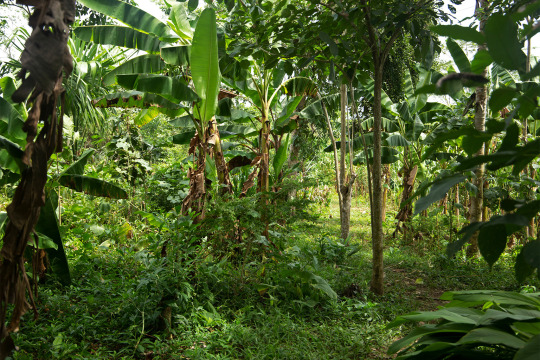
Pictured: Remberto Gil’s house is surrounded by an agroforestry system where turkeys and other animals graze under fruit trees such as maracuyá (Passiflora edulis), papaya (Carica papaya) and banana (Musa acuminata colla). Medicinal herbs like toronjil (Melissa officinalis) and tres bolas (Leonotis nepetifolia), and bushes like ají (Capsicum baccatum), yam and frijol diablito (beans) are part of the undergrowth. Image by Monica Pelliccia for Mongabay.
“Climate change is scary due to the possibility of food scarcity,” says Rodrigo Hernandez, a local authority with the Santa Isabel community. “Our ancestral seeds offer a solution as more resistant to climate change.”
Based on their experience, farmers say their ancestral seed varieties are more resistant to high temperatures compared to the imported varieties and cultivars they currently use. These ancestral varieties have adapted to the region’s ecosystem and require less water, they tell Mongabay. According to a report by local organization Grupo Semillas and development foundation SWISSAID, indigenous corn varieties like blaquito are more resistant to the heat, cariaco tolerates drought easily, and negrito is very resistant to high temperatures.
The Zenù diet still incorporates the traditional diversity of seeds, plant varieties and animals they consume, though they too are threatened by climate change: from fish recipes made from bocachico (Prochilodus magdalenae), and reptiles like the babilla or spectacled caiman (Caiman crocodilus), to different corn varieties to prepare arepas (cornmeal cakes), liquor, cheeses and soups.
“The most important challenge we have now is to save ancient species and involve new generations in ancestral practice,” says Sonia Rocha Marquez, a professor of social sciences at Sinù University in the city of Montería.
...[Despite] land scarcity, Negrete says communities are developing important projects to protect their traditional food systems. Farmers and seed custodians, like Gil, are working with the Association of Organic Agriculture and Livestock Producers (ASPROAL) and their Communitarian Seed House (Casa Comunitaria de Semillas Criollas y Nativas)...
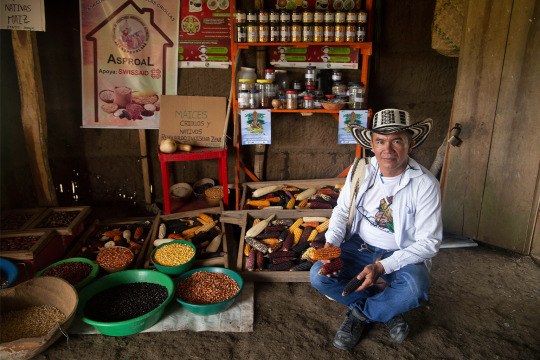
Pictured: Remberto Gil is a seed guardian and farmer who works at the Communitarian Seed House, where the ASPROL association stores 32 seeds of rare or almost extinct species. Image by Monica Pelliccia for Mongabay.
Located near Gil’s house, the seed bank hosts a rainbow of 12 corn varieties, from glistening black to blue to light pink to purple and even white. There are also jars of seeds for local varieties of beans, eggplants, pumpkins and aromatic herbs, some stored in refrigerators. All are ancient varieties shared between local families.
Outside the seed bank is a terrace where chickens and turkeys graze under an agroforestry system for farmers to emulate: local varieties of passion fruit, papaya and banana trees grow above bushes of ají peppers and beans. Traditional medicinal herbs like toronjil or lemon balm (Melissa officinalis) form part of the undergrowth.
Today, 25 families are involved in sharing, storing and commercializing the seeds of 32 rare or almost-extinct varieties.
“When I was a kid, my father brought me to the farm to participate in recovering the land,” says Nilvadys Arrieta, 56, a farmer member of ASPROAL. “Now, I still act with the same collective thinking that moves what we are doing.”
“Working together helps us to save, share more seeds, and sell at fair price [while] avoiding intermediaries and increasing families’ incomes,” Gil says. “Last year, we sold 8 million seeds to organic restaurants in Bogotà and Medellín.”
So far, the 80% of the farmers families living in the Zenù reserve participate in both the agroecology and seed revival projects, he adds."
-via Mongabay, February 6, 2024
#indigenous#ecology#agroforestry#agriculture#traditional food systems#traditional medicine#sustainable agriculture#zenu#indigenous peoples#farming#colombia#indigenous land#traditional knowledge#seeds#corn#sustainability#botany#plant biology#good news#hope#climate action#climate change#climate resilience#agroecology#food sovereignty
1K notes
·
View notes
Text

Sugarcane is a widely grown crop in the Nile Basin, but its destructive effects on soils, water resources and biodiversity have become increasingly apparent.
As the thirsty crop draws down water resources, aquatic species like the critically endangered Nubian flapshell turtle suffer a loss of habitat, forage and nesting sites.
In an effort to revive soils, diversify diets and incomes, and boost water levels that many animals rely on, communities are implementing agroforestry projects in lieu of monocultures.
The resulting “food forests” attract an array of wildlife while refilling wetlands and river systems where the culturally important flapshell turtles swim.
#good news#nile river#africa#kenya#nubian flapshell turtle#food forest#restoration#turtles#agroforestry#environmentalism#science#environment#nature#animals#conservation#sugarcane
488 notes
·
View notes
Text
In order to reach 350 ppm—the level we were at in 1988—we’d need to remove 500 billion tons of CO2 from the atmosphere. To hit the pre-industrial mark of 280 ppm, 900 billion tons. If we were to use plants to accomplish this, we would need them to add 138 billion tons and 249 billion tons of biomass, respectively. This is roughly the equivalent to 1.3 and 2.5 Amazon rainforests, respectively, if we count both above and below ground biomass.
So, what can we do with all that carbon? As the Amazon analogy implies, growing more forests would do the trick. In the last 10,000 years, the Earth has lost 7.7 million square miles of forest, equal to 2.85 Amazons. So we can exceed our target for atmospheric CO2 removal by returning to the 57% forest coverage of Earth’s habitable surface that we had at the end of the last Ice Age. That was the climate that allowed for the vast expansion of humanity, so that approach holds a lot of appeal.
Additionally, the Amazon analogy demonstrates that vast reforested areas can support human civilization beyond simply sucking down CO2. The Amazon itself is a vast food forest filled with edible species that were planted 4,500 years ago by its human occupants, who built a thriving civilization based on the readily available food surrounding them. A contemporary global reforestation initiative should also focus on edible species, thus serving the dual purpose of creating an abundant perennial food source and sequestering CO2. A mature food forest can yield at least 2,100,000 calories per acre with minimal inputs, enough to feed two adults. A stable climate PLUS more free food than all of humanity could possibly eat sounds pretty good.
It goes without saying that climate change is not the only ecological catastrophe facing humanity. We have crossed six of nine planetary boundaries, any one of which could spell our doom. A globe-spanning food forest would help address those looming disasters, such as biodiversity loss and biogeochemical flows, as well.
But there are challenges to the forestry approach. Environmental conditions have degraded immensely in the last 100 years, and it's possible that not all previously forested areas would now support trees. Some estimates put the possibility of reforestation at half of the 7.7 million square miles lost and argue it would take thousands of years to accomplish. I have doubts about these estimates, but it's important to be cautious. Additionally, the principle of redundancy is crucial in permaculture, and it's not hard to see how it applies here: we would not want to put all our eggs in one basket with the future of life on Earth at stake.
So how can we move faster while diversifying our risk?
112 notes
·
View notes
Text
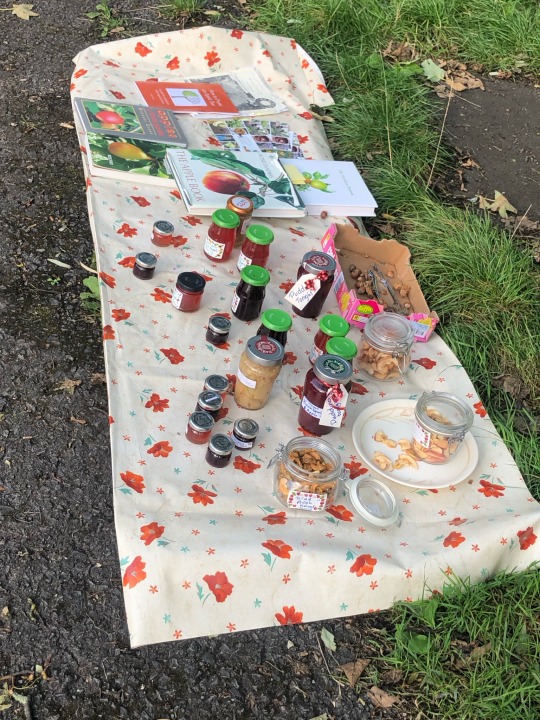
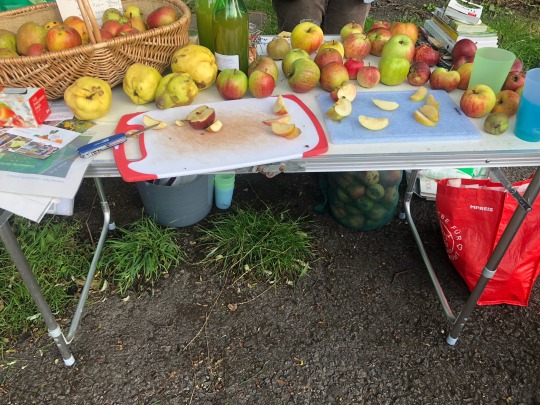

Apple tasting at my local community orchard! Delicious healthy food fresh from the tree, for free. Pretty fucken solarpunk
#solarpunk#hopepunk#environmentalism#social justice#cottagepunk#optimism#community#climate justice#bright future#local food#slow food#agroforestry
95 notes
·
View notes
Link
Nowadays, most wood is harvested by killing trees. Before the Industrial Revolution, a lot of wood was harvested from living trees, which were coppiced. The principle of coppicing is based on the natural ability of many broad-leaved species to regrow from damaged stems or roots – damage caused by fire, wind, snow, animals, pathogens, or (on slopes) falling rocks. Coppice management involves the cutting down of trees close to ground level, after which the base – called the “stool” – develops several new shoots, resulting in a multi-stemmed tree.
[...]
Because of the short rotation cycles, a coppice forest was a very quick, regular and reliable supplier of firewood. Often, it was cut up into a number of equal compartments that corresponded to the number of years in the planned rotation. For example, if the shoots were harvested every three years, the forest was divided into three parts, and one of these was coppiced each year. Short rotation cycles also meant that it took only a few years before the carbon released by the burning of the wood was compensated by the carbon that was absorbed by new growth, making a coppice forest truly carbon neutral. In very short rotation cycles, new growth could even be ready for harvest by the time the old growth wood had dried enough to be burned.
#sustainability#environmentalism#green energy#renewable energy#degrowth#solarpunk#low tech#agroforestry#forestry#deforestation#reforestation
142 notes
·
View notes
Note
I have a gardening tip for your followers! I love to garden but it is so expensive to get started. I repurpose old boxes and disposable/fast food cups as planters (just poke holes in the bottom for drainage and set them on top of a towel) and I made a small watering can out of a bottle with holes poked in the top. It works great because I don't need a massive watering can in my apartment. Gardening at home can be super cheap and easy!

[ID: a cardboard box that has been turned into a planter containing soil and seedlings. A plastic water bottle stands beside it and has holes poked in the top to serve as a watering can.]
Gardening and makeshift planters
Thank you for the tip! Gardening can seem quite daunting if you've never done it before, so asks like these are nice ways to show people it doesn't have to be all that complicated.
I wholeheartedly support DIY containers! Is that a cardboard box in your picture? Doesn't it get soggy? Or did you put in some kind of lining? Love your bottle watering can!
Gardening options:
Most people imagine a vegetable plot with annual plants and crop rotations when they think about gardening. This type of garden definitely has its merits, but it's not the only option. A garden can be as complex or as simple and as big or as small as you choose to make it.
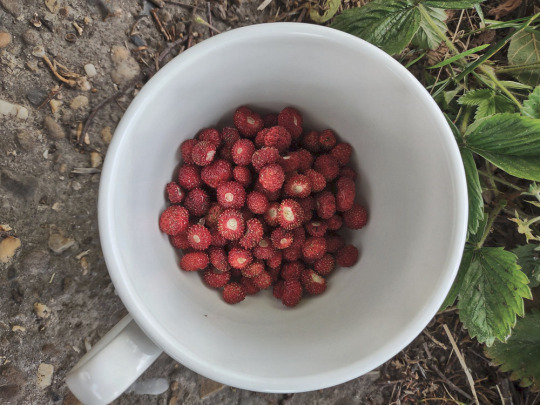
[ID: a white bowl filled with small woodland strawberries. The bowl sits on a gray stone pathway next to a patch of wild strawberry plants.]
Backyard:
If you've got the luxury of having a garden in which you can do whatever you want without landlords watching over your shoulder, you're super lucky! There's so much good you could do!
Your garden can be a massive boon to your local biodiversity and wildlife. Even just planting native wildflowers or adding some wildlife garden elements will help. Make sure to look up local resources when planning a garden like this!
Your garden can also help to make your surroundings more comfortable. For example, trees and bushes will cool down their surroundings and can improve air quality. Gardening can even be used as a tool for carbon sequestration. And who doesn't like watching flowers bloom?
You could also try your hand at growing your own food. You could start a plot with kitchen herbs, grow a few vegetables or edible flowers, put in a few fruit bushes, and trade excesses with friends. Don't be fooled by Pinterest though, your chances of being able to live off your own produce are minimal.
Combine these different functions, if you can. For example: I've planted a wild strawberry patch in my garden. It functions as a ground cover and keeps my soil moist, provides me with the occasional snack, offers pollen to bees, and whatever berries I don't pick serve as food for the wildlife in my garden.
Keep things safe and easy:
Start out small! Don't get overwhelmed.
Figure out how much sun your plot gets before planting anything.
Use perennial plants instead of annuals if you have limited energy.
Trade seeds and seedlings with fellow gardeners, or learn how to propagate plants to keep costs down.
Look into lasagna gardening if you're unable to dig, or raised beds if you struggle with mobility.
Mulch your plots to save on water and weeding time.
Use localised information when planning your garden.
Avoid pesticides, especially if you plan to eat what you're growing.
Get your tetanus shots up to date, watch out for ticks, leave wild animals alone, and be careful if you have allergies.
Don't eat plants unless you're a 110% certain of what they are. Foraging can be fun, but you really don't want to mistake lilly of the valley for wild garlic.
Be mindful of your neighbours and housemates. Living near an allergen sucks, and certain plants can be dangerous to small children and pets.
Mint. Don't do it. It's a trap. It'll take over both your garden and your nightmares. Put it in a container if you really want to grow some.
If you've got a lot of space, you could look into permaculture or agroforestry.
Community plot:
Don't have a yard? Check if your neighbourhood has a community garden, or start one yourself. Shared gardens are a great way to get to know your neighbours.
Container garden:
If you don't have a lot of space, you could try container gardening. You can use pretty much anything to grow plants in as long as it's water tight, non-toxic, has drainage holes at the bottom, and is large enough for the type of plant you want to put in it. If you lack surface space, vertical gardens are also an option.
Note that container plants need more frequent watering and rely on you for nutrients.
The size of your garden project won't effect just how meaningful it can be. A native plant on a balcony can be an important spot for local birds or butterflies. The flowers in your vertical wall garden might be the only available pollen source in your neighbourhood. That potted basil on your window sill will give you a well-deserved sense of pride over keeping it alive every time you pick a few leaves for your pasta.
#wasteless crafts#ask#gardening#planter#diy planter#container gardening#thanks for this ask!#I've been meaning to write a post about gardening so this is the perfect excuse#container garden#wildlife garden#permaculture#agroforestry#ecology#wildlife#nature#gardening for beginners#vertical gardening#community garden#carbon sequestration#mulch#lasagna gardening#raised beds
422 notes
·
View notes
Text
Currently reading 'Trees with Edible Leaves' (Perennial Agriculture Institute - Toensmeier & Klopf, 2022) and it is a fantastic read. It has been made freely available under the the CC-BY-NC-ND 2.0 license, and I put the link to the blogpost where you can download it in the book title. It's also embedded in the page, so readers don't need to download it.
It's neatly divided into sections according to climate type, has reference images, and is written for the layperson instead of expecting specialised knowledge from the reader. Names for plants are provided - where possible - in the 20 most spoken languages. 10/10 would recommend for anyone interested in carbon friendly solutions to food and nutrition problems. Happy reading!
128 notes
·
View notes
Photo
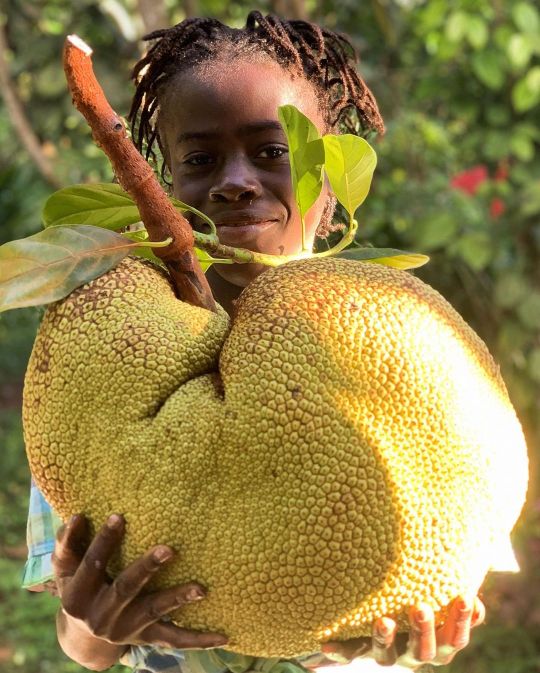
Jackfruit is most definitely the king of fruits. So abundant and so versatile! #growninhaiti #jackfruit #harvest #community #sharingiscaring #foodsecurity #abundance #regenerativefoodsystems #haiti #ayiti #reforestation #foodforest #agroforestry #organic #nogmos #nopesticides #noherbicides https://www.instagram.com/p/ClHDpteOplF/?igshid=NGJjMDIxMWI=
#growninhaiti#jackfruit#harvest#community#sharingiscaring#foodsecurity#abundance#regenerativefoodsystems#haiti#ayiti#reforestation#foodforest#agroforestry#organic#nogmos#nopesticides#noherbicides
138 notes
·
View notes
Text
My dream is to build and live in a very large self-sustaining Roman villa, surrounded by agroforestry systems and running a small town that lives off of agroforestry with aesthetics and government system inspired by the Roman Republic.
Also a colosseum for events and a central Thermae would be nice.
58 notes
·
View notes
Text
Agroforestry with oaks and hemp for more biodiversity, reforestation and soil improvement
Agroforestry, forestry and agriculture with oaks and hemp can improve soils, biodiversity and water balance, that's why Greening Deserts launched the program Agrarhanf.com, Bodenrettung.com und Eichenwald.org. Oaks harbor and enhance biodiversity more than any other trees!

The contributions and projects are intended to support forestry and agricultural managers with useful ideas, impulses and innovative solutions. We recommend planting tree rows more densely in the beginning and then singling out individual trees as the years go by. In the beginning, larger trees can be planted and slightly smaller ones in between, which are then useful as replacements and for the region. This technique is very proven in Eastern Europe and the agroforestry is therefore also a kind of tree nursery. Agroforestry systems are less susceptible to forest fires.
Mitigation of climate change impacts through healthier and stronger ecosystems, higher soil and air moisture are essential for survival, especially with the increasing loss of cropland worldwide. Flowering trees and wildflowers on trees can attract more pollinators and important insects (beneficial insects) which, like birds, also reduce pests. Agroforestry is therefore one of the best ways to adapt to climate change and extreme weather events such as droughts.
Alternative tree species with nutritious berries and nuts as well as hardy palms can be found on Greening Deserts project pages and naturally on the Leipzig Palms Project. In the meantime, there are also plenty of suitable industrial hemp varieties, just read the official regulations for the cultivation of hemp in Germany. We recommend undemanding, tall-growing and narrow hemp varieties for the production of hemp fiber. Bushier sorts for more leaves and hemp seeds, such as for food and feed. Commercial hemp can significantly reduce nitrogen and methane emissions, this has been confirmed many times by international researchers and studies. Some hemp varieties require very little water and can improve long-term biodiversity, nutrient supply and soil moisture. Similar to lupines, hemp can also be used as a green manure, for example if there are times when yields or growth are not so good in individual years, the plants can be added to the soil after harvesting together with compost and / or leaves. For hemp cultivation, no pesticides and very little fertilizer are needed.
There are multiple options of tree planting, especially drought-tolerant oaks! Planting of pre-germinated seeds, e.g. germinated acorns, transplanting of young plants and cuttings around old trees in open areas in the forest or at the forest edge. Purchasing perennial oaks and seedlings from nurseries especially for urban regions and urban areas where larger trees are needed. If there is extreme abundance of oaks and saplings in some years, they can be taken from old trees. Otherwise it would be a pity if they die in the forest due to lack of light or are destroyed by mowing on meadows in the park. As a result, many millions of oaks are probably lost every year. The projects, campaigns and initiatives should also change or improve this, for example by showing how to do it, giving useful tips and having many people follow the movement. Not only people from the concerned areas but also people from all areas and branches, also from the educational area, for example young people from schools and students from universities. After all, collecting and planting oak trees is not only a nice balance to intellectual work, it is good for health and properly implemented also a kind of sport. In addition, one is more outside in nature and can learn a lot.
One can harvest acorns very effectively in places with the raking and a special vacuum cleaner, sustainably and only a part at a time, especially at half mast and blast mast. As some clever farmers, foresters and forest owners have already done. Every year there are acorns in abundance, according to estimates several thousand tons, sustainable harvesting would not harm ecosystems, on the contrary... too much acorns are not good for soils! You can harvest acorns very effectively in places with raking and a special vacuum cleaner, sustainably and only a part at a time, especially with half mast and blast mast. As some smart farmers, foresters and forest owners have already done.
With healthy and natural feeds like hemp and acorns you can replace many of these feeds in the short term and in the long term! Especially oaks with large fruits are suitable for agroforestry, where rows of trees are planted in fields. Useful crops can then be grown between the rows. Acorns are good not only for animals, but also for humans, as a healthy addition to the diet or medicine. Acorn meal is very healthy and acorns with residual bitter compounds are good for the stomach and intestines.
The potential for more sustainable livestock production is enormous. In Spain, animals are partially fed on oak trees. Iberian acorn-fed pigs eat only acorns, grasses and herbs from pastures. Acorn fattening and pig fattening could also in Germany not only reduce feed costs, costly and environmentally harmful procurement of feed. It would protect together with increased hemp cultivation soils and forests worldwide, since soils are destroyed less by deforestation and harmful crops. Of course, meat consumption or production should also be reduced globally - especially overproduction and senseless waste.
There is simply too much food being wasted, thrown away or going bad; improved distribution and preservation through better or faster drying could help. At the same time, less environmentally damaging crops such as corn, canola and soy should be grown along the way. Particularly intensive agriculture damages soils; oily plant parts can seal soils or repel water. This is fatal when prolonged droughts dry out the soil severely and rain then does not seep in well in many places or even runs off completely on the surface.
In order to bring forward topics such as species conservation, biodiversity, education, climate and environmental protection, as well as to promote a more sustainable forestry and agriculture, we want to increasingly involve schools and universities in our actions as well as projects in the years until 2030. The Oak Park and Oak Forest project Eichenwald.org was established together with the Schools Forest Initiative in 2019 and 2020.
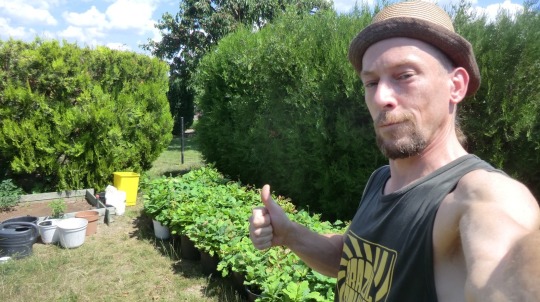
We want to plant about 50,000 trees for and region, together with schools and school classes. The floodplain forest could be extended by a few meters at the edges! If one the relationship of the enormous meadows and open spaces which lie around the Auwald and forests in Saxonia one asks oneself why no or so few forest extensions were made until today. There is enough space around the alluvial forest and forests in Saxony. One does not need therefore necessarily a new forest to plant. Already on a meter band more forest at the edge of the forest thousands of new trees could be planted! If the work and projects are finally financially and actively supported, the actions and projects can be implemented more quickly, even by the end of 2023. Otherwise, due to lack of money and time, all the work and other important projects of the founder can unfortunately not hire helpers, get equipment or stuff is needed and will plant the oaks themselves over time and then plant out somewhere else. Then, unfortunately, there will be no Leipzig forest expansion with many important tree species and oak varieties. Because without any payment and support it simply does not work, especially under the current circumstances and plight of the founder, which lives since spring at subsistence level. The Oak park and forest actions since a few weeks takes almost all working time and free time, if there comes no support thousands of sprouted acorns will be planted in buckets, pots and bags. This saves a lot of time and ways.
Almost 40,000 oaks have already been planted over the years in Germany and regions of Europe. These are now well adapted to the drought, because they were planted out early and thus could root deeply. In Leipzig and region about 12,000 oaks were planted out! The founder of the Urban Greening Camp and Vertical Farming Startup has collected acorns from many different trees, these can then be easily put into the ground when they have germinated. The germination rate is very high and the mortality rate very low because oaks root very quickly and deeply - so they survive drought years quite well as we have unfortunately had more often now.
Oaks support more biodiversity than any other German or native trees. Individual specimens with hundreds of species have been discovered and recently even a world record with well over a thousand species! As some Greening Deserts articles and projects have already well shown or extensively explained. Projects and programs like the Trillion Trees Initiative have been exploring these relationships for years, especially the relationship between biodiversity, healthy ecosystems and trees that are essential for the survival of many other species. If we save, protect and propagate key tree species on which many other species depend, we also protect many thousands of species in the plant and animal kingdoms, as well as soils, waters, microorganisms, insects and fungi! Key species and endangered tree species should be primarily introduced into ecosystems and forests. Various EU organizations and official bodies were informed the years several times - also directly by email and contacted with many letters, unfortunately ignored by many or answered only superficially. The Urban Greening and Vertical Farming Startup not only wants more creative urban greening with tree containers or raised beds and planting walls. It also wants to establish more mini-forests in Leipzig and the region, also to create hotspots for biodiversity. Municipalities, farmers and forest owners from all over Germany are invited to provide parts of their area(s) for this project.
It is a win-win situation for everyone as such a mini-forest promotes a good climate and insect diversity in the region, in addition various tree species can also be planted more densely to use them in the future for further reforestation or forestation in the region, this is not only logistically sensible, but also saves money, time and resources. The small forests can serve as a diverse nursery or growing forest, so to speak. Greening Deserts founders have been creating the concept for several years and to date it is mature, because it is to be implemented together with the emerging movement of agroforestry and agrovoltaics throughout Germany and then Europe. The main project can be reached under GreeningCamp or GreeningDeserts.com, in addition the Trillion Trees Initiative and various forest projects will support this movement in the future.
Greening Deserts founders and researchers explore with various projects not only drylands and arid ecosystems, but also wetlands such as floodplains, riparian forests, wet forests, bogs or swamps, lake and river landscapes. Long-term studies of marsh trees and wetland plants have been carried out, including photographic studies and in such a number of wetlands of Europe. Swamps and bog forests have been documented over many years. Results will be published with the projects and project developments like Eichenwald.org, MoorForest and SwampForest.org in the future. The international platform will then be accessible at WetForest.org. For years we have been recommending the reforestation and expansion of peatlands, which can store more carbon CO2 than any other ecosystem, and to further reduce emissions, especially methane emissions, trees should be planted. Swamp or bog trees such as swamp oak or bald cypress grow relatively fast and together with organisms such as bacteria and fungi can stabilize the water bodies or wet soils, in some cases even bind methane as well as convert it. Wetlands without trees warm up faster than moist forests which cast shade and are much cooler than open areas. This is also a reason why wetlands release more methane, forest ecosystems suffer from droughts or extreme drought, store less carbon and can even release it - especially through forest fires and dried out or destroyed soils. Mixed forests and tree species that favor soil moisture also have a much lower risk of wildfire. Trees can cool the area by many degrees, even in urban areas, almost all cities should know this by now.
Air pollution, insecticides and pesticides are not only a threat to bees, they also endanger many other species, especially near agricultural and livestock farms. Many of the trees and forests typically found in forestry are monocultures and conifers such as Douglas fir, spruce, pine, larch and fir - unfortunately, these do not provide much nectar. Nearly 80 percent of conifers were felled because of damage. At just under 70 percent, the share of damaged wood in total logging in 2019 was more than three times higher than in 2010. As already described in the article on the Leipzig Oak Park of Diversity project, strong tree species such as oaks are also affected. Whether due to pests, powdery mildew or drought stress, the plants suffer greatly from the drought. Like many deciduous trees, oaks belong to the deep-rooted species, which fetch water from lower soil layers. What they do not need themselves, they release closer to the surface. This makes oaks good soil regulators, for example through pronounced symbioses with microorganisms and fungi. Oaks and other robust trees are suffering from climate change, as are many people and animals. Tree damage and forest degradation result not only from fires, drought and heat waves, but also from fungal infestations, pests, snow breakage, storms, floods and environmental toxins - as well as air and water pollution.
According to climate research, long-term studies and weather experts, extreme drought is becoming normal in Europe in the summer. In spring, many places around the world also lack the water needed for healthy plant growth. Soils and forests can hold less water because the important reservoirs are not only dried out but damaged, i.e. the storage capacity is reduced and in some cases reduced for years. When middle and deeper soil layers harden, humus layers turn to dust or are destroyed, even a lot of rain will not help for the time being. It then takes years of moderate rain and some plant growth until these soil layers are loosened and watered again. Trees, hedges and other plants that can form complex, strong and deep roots need several years to loosen medium and deep soil layers again. This is why ground cover, soil conservation measures and deep rooting plants like thistles are so important. Greening Deserts has therefore started the project SoilRescue.eu and TrillionTrees.eu.
The destruction of soils by extensive agriculture, surface mining and drainage accelerates land degradation. A major problem is the hardening and water repellency of soils due to greasy or oily surfaces. Fats, oils, and waxes from plant parts fall to the ground with the particulate matter. Rain then cannot penetrate the top layer of soil and runs off superficially. Factors such as soil type, plant species, temperature and the degree of desiccation determine how water repellent the soil becomes. Often, soils cannot be loosened by plowing until after harvest. However, if the drought lasts for a long time, there is a risk of soil erosion by wind - especially in the fall there are more winds and storms. We can all only hope that there is not another winter drought, as this would damage the soils for years to come. Already in 2018, more soil conservation measures should have been implemented, such as covering with ground covers, emergency irrigation with extra canals, ponds and rainwater storage above ground or underground. There are some other effective and innovative methods such as agrophotovoltaics, hemp cultivation, and desert bamboo.
Due to tree mortality during drought years, Germany is missing billions of trees; these cannot be replanted quickly by private and state forestry companies. This is compounded by more difficult conditions due to extreme weather and future droughts. Many of the new forest plantings since 2018 have died, often far more than half of all young trees. Movements like Fridays for Future and school groups should be involved in a variety of reforestation and planting activities - such as collecting seeds, planting trees and wildflowers. Especially for children and young people, it makes sense to combine healthy exercise, nature and fresh air with meaningful actions for people and the environment. During the actions you can not only learn a lot but also get a better understanding of nature and the environment. Especially in this autumn there is a chance to collect millions of acorns for new plantations and to plant perennial trees. This can be done basically all winter long if it gets as mild as 2019, there were even weeks in January and February with spring temperatures.
Reforestation and other tree planting activities should be concentrated more in the fall and more in the spring with the current climate conditions. This will give the young trees more time to root deeper and have a higher chance of surviving in a new drought year. Of course, extra watering can be done, and often a simple plastic bottle with drip irrigation is all that is needed. This simple irrigation technique is often seen in Africa and India. So you don't need to buy new products or techniques for watering trees, there is already enough plastic waste! SchoolsForest and 'Schools Forest Up' is a project idea of Greening Deserts and together with other planting actions, in a community, could plant the areas with forest damage faster than you think.
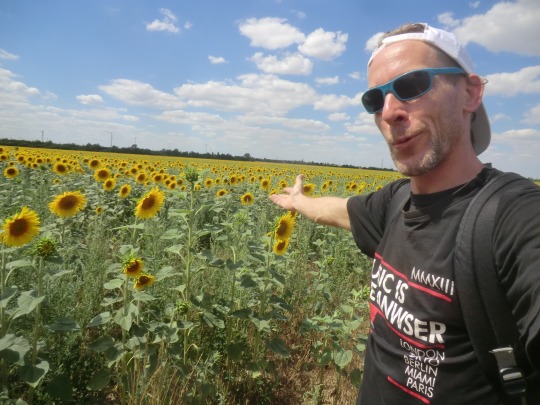
Contributions and quotes of Greening Deserts founder Oliver Caplikas:
Agroforestry is one of the best ways for forestry and agriculture to adapt to climate change and extreme weather events such as droughts. It allows for more sustainable agriculture and ecological forestry, as an agroforestry using only trees as a type of nursery is also possible. #ClimateAdaptation
Climate protection, nature conservation and environmental protection is species protection, so it is also human protection.
Europe should finally wake up and promote more hemp cultivation to support biodiversity, CO2 storage, ecosystem restoration and soil improvement - especially in drought regions and areas with deforested or degraded soils. More sustainable agriculture is possible if hemp production increases in European countries. Healthy agriculture with hemp also requires no pesticides and very little fertilizer or some green manure and mineral fertilizers such as rock meal every year.
Greening Deserts and Trillion Trees Initiative has been informing EU and parties for years about the problems of burning fossil fuels like wood and coal. Don't burn trees and forests, use hemp and rice straw for building, animal feed.... #agriculturalhemp.com #hempcultivation #industrialhemp.
Greening Deserts has launched new sustainable organic farming projects. One of them is called #Agrarhanf.de, a German project for industrial hemp that can improve biodiversity, animal and soil health - and reduce carbon and methane emissions! #organic farming #hemp fodder #hemp pellets.
Hemp can help improve air, climate, soil and water quality. Hemp plants support biodiversity and protect forests. Global hemp cultivation can reduce climate change impacts such as deforestation, desertification and global warming.
Hemp paper like hemp toilet paper can reduce deforestation and global warming worldwide! Prevent forest dieback with #hemppaper, improve biodiversity and soils with hemp farming. #agricultural hemp #soil saver #soil conservation #climate saver #utility hemp.
Feeding agricultural hemp to cows can lower their stress levels and improve their overall health. Hemp could replace corn, soy and other polluting crops - saving forests, soils and rainforests! Like sea grass, agricultural hemp can reduce methane emissions from cows!
Greening Deserts projects like agricultural hemp help farmers, growers and foresters with biodiversity, soil and climate protection by providing useful hints and advice, such as soil improvement, effective plant breeding, sustainable nutrition, cheap and environmentally friendly feed sourcing.
For several years, Greening Deserts projects have been recommending politics and business to finally promote / encourage soil improvement with agricultural / industrial hemp on a large scale. See article Hemp cultivation in surface mining. Not much has happened to date. #agricultural hemp #hemp paper #hemp seed
Many companies in Germany are dedicated to paper production, hemp paper production is largely absent. The machines or production is set on waste paper or pulp. German machinery and paper manufacturers do not produce hemp paper on a large scale. #hemppaper
We don't have much time left to stop global warming and the loss of biodiversity, of which cities and urban areas are a very large part. The simple formula applies: Urban Greening = Urban Cooling. That is why the projects like Greening Camp and the private organization GlobalGreening.org, among others, were founded. Global greening is the only large-scale and nature-based solution to noticeably cool the planet and particularly affected regions. With this, it may be possible to get back below 1.5 degrees by 2050.
We hope that Europe and Germany will finally use more hemp for biodiversity and large-scale soil improvement and drought protection. Drought or drought tolerant plants and trees such as sweet chestnuts, oaks,.. can improve agroforestry and ecological forestry in the long term and sustainably.
*Acorn fattening, also commonly called eckerich in German-speaking areas, was a widespread agricultural practice in Central Europe until the 19th century. Domestic pigs were driven into the woods to gorge themselves on acorns, beechnuts and chestnuts. The word "fattening" originally referred to the tree fruits used as cattle feed. Later it was restricted to acorns and beechnuts used as pig feed. Today, the word mast is generally used to refer to the "fattening" of animals. In addition, the seed production of oaks and beeches was called, for example, eckerich, ecker, acker or acker. From this, the acker was derived from an agricultural point of view. - Wikipedia
#Artenschutz#Artenvielfalt#Agroforstwirtschaft#agroforestry#acorns#biodiversity#conservation#climate adaptation#climate and environment#drought#german#Germany#hemp#industrial hemp#oaks#forests#reforestation#ecological#chestnuts#bees#soils#oak park#species rescue#species protection#urban greening#nursery#vertical farming#tree species
66 notes
·
View notes
Text

Imersão Agrofloresta: uma oportunidade para regenerar o solo e o meio ambiente. Agroforestry Immersion: an opportunity to regenerate the soil and the environment.
6 notes
·
View notes
Link
“As the planet grapples with growing hunger and an uptick of climate change-driven droughts, torrential rains and flooding, experts and authorities from the United Kingdom to Uganda, as well as Brazil’s incoming government, increasingly tout regenerative agriculture to tackle the interconnected crises.
Brazil’s agroforestry advocates say it is a sustainable alternative to soy monocultures and cattle ranching that could help restore roughly 30 million hectares (74 million acres, a little larger than the U.S. state of Arizona) of degraded pastures in the Amazon.
Supporters argue that well-planned and managed agroforestry systems can provide a decent and stable income for the Amazon’s small farmers, many of whom are extremely poor, while protecting the environment by increasing biodiversity and carbon stocks.
“It is perhaps one of the only tools we have to carry out regenerative agriculture that is linked not only to climate goals but also to poverty and hunger reduction goals,” Tomaz Lanza, a consultant, expert in agroforestry and doctor of agronomy, told Mongabay by video calls.
Often referred by the Portuguese acronym SAFs, agroforestry systems combine species as varied as açaí, andiroba, copaíba, cupuaçu, cacao and banana, together with crops such as corn and manioc with trees in relatively small patches of land — a practice that is actually centuries old.
“The populations of the Amazon have been practicing the agroforestry system since they developed agriculture, 2,000 years before the European invasion of Brazil,” Judson Valentim, an agronomist and researcher at Embrapa, told Mongabay by phone...
RECA, with more than 30 years of experience, is for many a blueprint of what sustainable agriculture in the Amazon could look like.
Mongabay traveled to RECA two days after Luiz Inácio Lula da Silva won Brazil’s presidential elections by a narrow margin. The veteran left-winger has promised to put protection of the Amazon at the forefront of his agenda and has signaled lower interest rates on rural credit for sustainable productions and recuperation of degraded areas...
The cooperative was officially founded in 1989. Today, RECA sells high-value goods like jam and pulp across Brazil and even for export, with açaí and cupuaçu products the biggest earners. The cooperative also has a carbon credits program with cosmetic giant Natura, by which the farmers receive economic compensation for protecting the forest and reducing carbon emissions in the company’s supply chain.
Along with the Tomé-Açu Mixed Agricultural Cooperative (CAMTA) in Pará state, experts consider RECA the most successful example of agroforestry in Brazil’s Amazon.
For Valentim, the researcher, a huge part of RECA’s success comes down to its organizational model as a cooperative. He touts the economic benefits of the agroforestry model not only as a way of lifting small farmers out of poverty but offering perspective for the future, halting Amazonian migration and the advance of the deforestation frontier.
“An agroforestry system with açaí and a consortium of cultures including a short-term production crop can place a farming family with 5 hectares of land in the Brazilian middle class,” he said.
Agroforestry systems are more resilient economically because producers are less exposed to price shocks if the value of a product changes, but also environmentally, key at a time of increasingly accelerated droughts and floods.” -via Mongabay, 12/9/22
#mongabay#mongabay environmental news#environmental news#conservation news#conservation#brazil#amazon#amazon rainforest#agriculture#agroforestry#poverty reduction#lula da silva#good news#hope#reforestation
252 notes
·
View notes
Text
The Nature Conservancy is leading the Expanding Agroforestry Project to provide training, planning and funds for 12,140 hectares (30,000 acres) of new agroforestry plantings in the U.S.
Goals for the program include enrolling at least 200 farmers, with a minimum of 50 from underserved communities.
Initial applications have surpassed expectations — 213 farmers applied in the first cycle with 93% coming from underserved populations.
The first round of payments is set for distribution in fall 2024.
#good news#agroforestry#agriculture#environmentalism#farming#environment#global climate change#climate crisis#climate change#usa
47 notes
·
View notes
Text
“We are seeing a growing interest in cork as a sustainable material,” says Rui Novais, a materials expert at the University of Aveiro in Portugal. “Compared with materials like polyurethane foam [used for thermal insulation], products made with cork require less energy and produce less CO2 emissions.”
The cork oak’s thick bark adapted to defend the tree from fire, making it a powerful insulating material that’s been used to shield fuel tanks on NASA spacecraft and electric car batteries. It’s also resistant to water and oil, and can withstand compression while retaining springiness.
“It’s an extraordinary, renewable and biodegradable material,” says Novais. “It’s also very durable. It has been demonstrated that cork products remain virtually unchanged for more than 50 years.”
Part of the carbon absorbed by cork oak trees is transferred to cork products, which can be used for long periods, repurposed and recycled. Several studies found that cork is carbon negative, meaning it can store more carbon than what is required to produce it.
When cork planks are trimmed and punched to form natural cork stoppers, the leftovers are ground into granules and pressed together to form cork sheets or blocks. “Even cork dust is used to produce energy,” says João Rui Ferreira, secretary general of the Portuguese Cork Association. “It feeds the industry’s boilers and powers some of the production.”
[...]
Most of the cork produced in Portugal grows in the gently undulating hills and plains in the south of the country, in an ancient agroforestry system known as montado. This savannah-like ecosystem combines cork, holm oaks and olive trees with pastures, grazing livestock, crops and fallows.
“The soil in southern Portugal is very poor, there is very little rain and temperatures are very high in the summer,” says Teresa Pinto-Correia, a professor at the University of Évora in Portugal specializing in rural landscapes and agricultural systems. “But this kind of system is productive even when resources are scarce and conditions are difficult.”
For centuries, locals have preserved the montado because cork provided landowners with a source of income. This mosaic of habitats supports hundreds of species, including the Iberian lynx, the world’s most endangered wildcat, and the threatened Imperial eagle. One of the world’s oldest known cork oak trees, planted in 1783 in Águas de Moura, is known as “the whistler” because so many birds visit its large sprawling branches.
Iberian pigs feed on acorns and goats graze the interwoven pastures. Interspersing cork oak trees with animals and crops can boost production and biodiversity, but also build soil, control erosion, retain water, combat desertification and sequester carbon, says Pinto-Correia.
138 notes
·
View notes
Photo
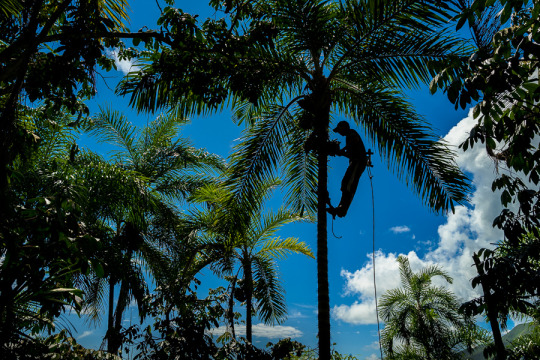



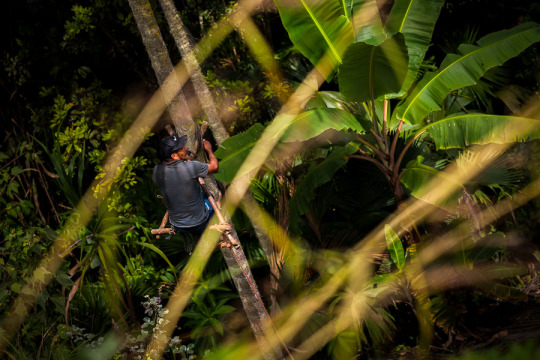
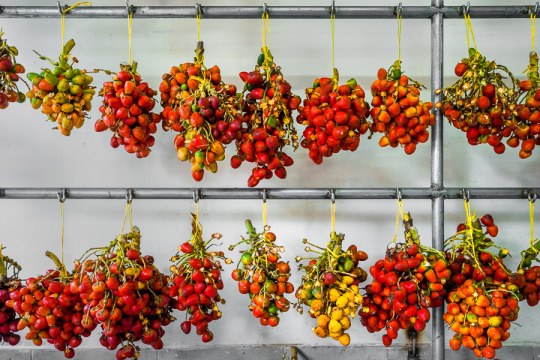
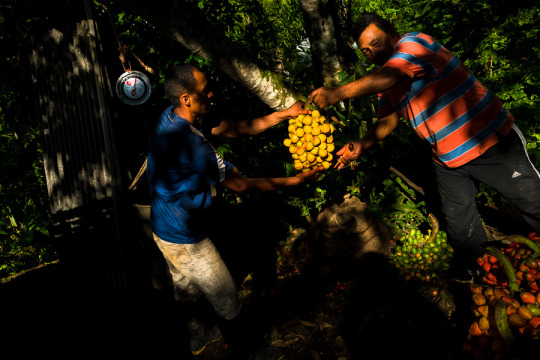



Chontaduro, a palm tree native to humid tropical forests, has been grown by indigenous people in the Americas since ancient times. Today, the peach palms are often cultivated by smallholders in agroforestry farms in the Pacific lowlands of Colombia. Although chontaduro fruits must be cooked for a couple of hours before consumption, it is one of the most popular Colombian street foods, usually served with salt and honey. The pulp of a boiled chontaduro is dry and has a starchy flavor. Due to its richness in essential oils, unsaturated fatty acids, proteins, and high nutritional value, chontaduro is considered a superfood. - Copyright © 2022 Jan Sochor Photography
24 notes
·
View notes
Text
HoW Africa drylands can stabilize the Global climate?

Regreening Africa aims to reverse land degradation on 1 million hectares across 8 countries in Africa. So far, the project has improved the #livelihoods, food security, and climate resilience of 500,000 households by restoring ecosystem services.
#Regreening#land degradation#hectares of forests#projects#tree planting#drylands#climate change#sdg15#evergreen agriculture#agroforestry#reforestation
5 notes
·
View notes